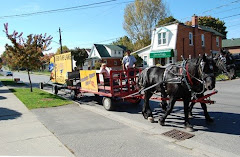The attack began Easter Monday, April 9, 1917. By the time it was over, Canada had secured its place in history as an army, as a nation, and as a people, and we've come to understand that deeply in the last 100 years. But I wondered: how was the battle seen at the time, how was it read and understood by the people of Guelph through their daily newspaper? To the microfiche!
The front page of the Guelph Evening Mercury on April 9 didn't have much in the way of details yet, but it was known that something major was happening in Europe. In the April 5 edition of the Mercury the headline read "Signs Point to Great Battle Coming on Western Front," as the articles detailed how British and French armies seem to be maneuvering along the front lines to launch a major new offensive.
Local news was still top of mind. A potentially devastating fire at Gilson Manufacturing on York Rd was avoided thanks to the "quick action" of Chief Smith and "the efficiency of the Guelph Fire Department" in preventing "what looked like the start of a big blaze." That same night, the Finance Committee met till midnight at City Hall with the assumption that "the Sewage and Public Works Commission will suffer from the effects of the slicing knife."
But big international news forced all other considerations off the front page for the next couple of days afterward. Despite a filibuster from 12 senators that made up the pacifist wing of Congress, the United States finally entered World War I. A political cartoon showed Uncle Sam being dragged off a cliff by a giant hand coming out of the water, but the U.S. war machine rolled to life with some help from one of history's most famous inventors. "Thomas Edison Working Now to Curb Submarine Menace," read one headline. Meanwhile, William Jennings Bryan, who was one of leading pacifists in Washington, pledged to serve the army if called, but being a 57-year-old man, he did not end up drafted into military service.
The same could not be said for 350 more young men from Guelph. An article in the April 9 edition said, "What is likely to be the last appeal made by the Dominion Government for voluntary enlistment is contained in a letter which is being sent to the young men of Canada." Lt. Col. John Mutrie, the chief recruiting officer for the district that included Guelph, had a list of 350 names of "residents of this city who are without dependents and who, according to their own statements, could and should offer themselves for military oversea service."
As for the battle, the first sign that something big was happening for Canada at the front was a small article with the headline "Canadians in Big Offensive at Arras." Arras was a town in France, and Vimy was part of an overall Allied offensive called the Second Battle of Arras. Canadian Press reporter Stewart Lyon had heard several times in the week before the battle that Canadian forces were taking part in raids "in the vicinity of Arras," which was five miles south of Vimy.
The picture was a great more clear by the time the April 10 edition of the Mercury was on the strands and door steps. "Canadians Win Imperishable Glory by Capture of Vimy Ridge," read the headline. "There was severe fighting during the night at the northern end of Vimy Ridge," reported Field Marshal Douglas Haig in the article. The British Commander-in-Chief told reporters that the Canadians had taken 9,000 prisoners and 40 guns. "The enemy was ejected, and a counter attack by them failed. The eastern slope was cleared and the counter attacks repulsed."
Vimy, of course, was infamous for how it repelled army units from both France and Britain. Germany took the escarpment in October 1914 and had held in continuously for going on three years when Haig began his eastward push; only the French 1st Moroccan Division managed to make any progress, taking the ridge briefly in 1915 only to lose it again when reinforcement came up short. That all changed on April 9, 1917 though. Of such significance was the victory that the Canadian forces were given kudos directly from King George V himself. "Canadians Advance to the Battle Singing," read one headline, marking the victory in a way that says in a modern cynical context that not only is war fun, it's easy.
But what about casualties? Any mention of the dead, the wounded or the missing was saved for the April 11 edition of the Mercury, as a front page article promised "Casualty Lists Expected to be Light." According to the report, 89 officers were casualties in the first day of fighting. "The number of casualties among the rank and file is not yet available for publication. Usually the rate of casualties among the men to casualties among officers is about 20 to 1. It is estimated that the total casualties among the men for the first day does not much exceed 1,500."
By the time it was over, 3,598 men were killed, another 7,004 were wounded.
In the April 12 Mercury the news had turned from what the Canadians had accomplished to what sounded like an insatiable thirst for battlefield victory. "The war critic of the London Standard says he understands that all four Canadian divisions are engaged in the present battle of Arras and that all four went over that famous Vimy Ridge on Monday morning." Reports were saying that Canadians were now part of a drive along the forward lines. "On both sides of the Souchez River they have moved northeastward from the direction of the village of Souchez, threatening to break between Angrea and Givenchy. This is the first indication of the crumbling of the Lens salient to the north of Vimy Ridge."
Haig reported on the Canadians' progress saying "We captured two important positions of the enemy lines to the north of Vimy ridge. Astride the river at Souchez a number of the enemy were taken prisoner," he said. "Two hostile attacks against our new positions at the northern end of Vimy ridge were driven off by machine gun fire, which inflicted heavy losses on the Germans."
Unconfirmed reports also made the news that the Canadian forces had taken a mile of German trenches south of Vimy, but elsewhere in the paper was a reminder that the war was still far from over. "Germany has her reserves ready, and is about to hurl her full forces against the allied long on the west front, according to Gen. F.B. Maurice, director of military operations, in an interview today."
In Friday's paper (April 13), the war seemed to return its dull roar, and the usual updates of battle maneuvers and political posturing. The front page started to feature more news from the homefront as the 500 Club in Guelph collected funds for Belgian relief, and the need was so great that the Montreal office of the Belgian Relief Society had personally sent a letter to Guelph lawyer R.L. McKinnon, secretary of the Local Associated Relief Board, asking for a greater effort. McKinnon's work had already raised a then impressive $3,173.50, with another $1,400 raised by the Mercury itself ("by publicity alone," said the paper, "without any personal solicitations").
Money issues were plentiful in the Mercury in the days following Vimy. One article in the April 14 edition warned "Prices remain high for all produce offered for sale on the market," as "scarce" potatoes would cost you 85 cents per basket, while apples would set you back between 75 cents per basket. On the other hand, maple syrup was plentiful, and butter saw some price relief at 42 cents. The City of Guelph, meanwhile, was looking for its own relief, the cost of lugging coal on the Guelph Radial Railway up to the Ontario Agricultural College was costing them at a loss of $1,000 per month under an old agreement between the railway's original owner George Sleeman and the Government of Ontario. The OAC was now using three-times the coal than when the City bought the train at the turn of the century.
On April 16, Guelphites, and all Canadians, were being asked to make a new contribution to the war effort. "That on the third Sunday in April the clocks in the Dominion should be put ahead one hour was the proposal made this morning by a delegation representing the various Canadian Boards of Trade." And 100 years later daylight savings isn't the only thing that's stayed with us from April 1917.
























No comments:
Post a Comment